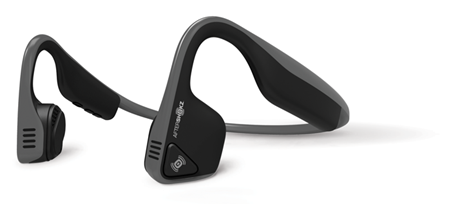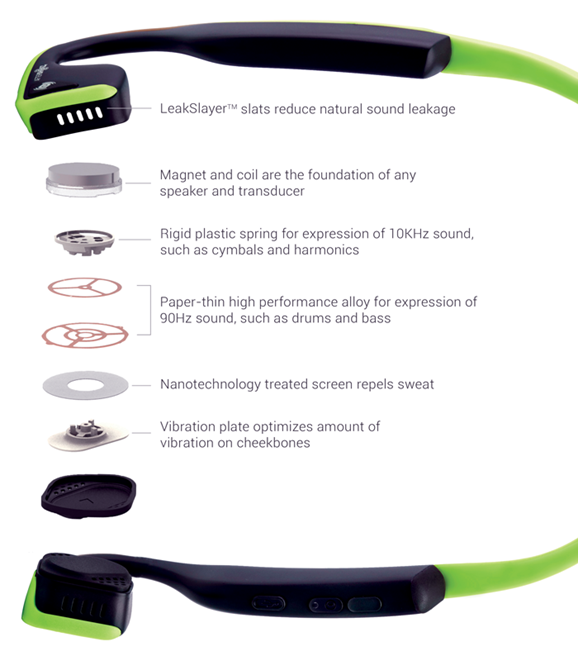Trekz Titanium wireless headphones claim to be the safest alternative to traditional sport headphones, delivering music through the cheekbones and leaving the ears free to hear all surrounding sounds. Designed with athletes in mind, Gareth Smith donned his running gear and put them to the test.

Recently, industry has put considerable weight behind changing the style of headphones for leisure use. This is, of course, coupled with the smartphone revolution. As with lots of current technology, ‘wireless’ has become the buzzword for headphones. There is a plethora of headphone styles in use: over-ear, in-ear and breaking into the scene – bone conduction.
Bone conduction headphones are being cleverly marketed: the product on review here appeared recently in the BBC’s programme, The Apprentice, where the hapless candidates made their usual ill-conceived attempt to market them to the public and retail outlets. Behind this tomfoolery, the message for bone-conduction headphones filtered through.
Bone conduction (BC) is hardly a new concept; hearing aid devices using BC have been available from the late 19th century, with earlier ‘rod’ devices being used to help the hearing impaired from the 17th century [1]. Much of an audiologist’s concept of BC devices will be based on their experience of using the bone conductor transducer whilst performing pure-tone audiometry or using bone conduction hearing aids. Both of these scenarios led to preconceptions of bone conduction headphones for leisure use.
As part of my standard audiometry patter, I will say prior to putting on the bone conductor transducer, ‘this is likely to be a little uncomfortable, but don’t worry, it won’t be on there long.’ This was a major preconception of BC headphones – they will simply be uncomfortable given the forces we are applying during BC placement. On hearing aid BC devices, Dillion [2] goes as far as saying “this force, combined with the small contact area of some bone conductors, creates sufficient pressure on the scalp that the devices are uncomfortable to wear”.
So, since this technology is centuries old and well-known, at least in audiological and ENT fields, how has it made it to ‘Spotlight on Innovation’? In this case, the innovation is through the application of the technology. The ‘unique selling point’ (USP) is the technology’s ability to keep the ears open to environmental noise, whilst allowing the wearer to listen to music and audio books or take calls. This, in a world where we want to remain engaged with our technology at all times, allows a degree of safety.
The scenario, and one used by the Apprentices, is the cyclist who wants to listen to music on the daily commute but would like to be able to hear the traffic around them: this product, unlike traditional headphones, allows that to happen. Equally, and this is the application for which I was reviewing the device, the runner who wants to hear the world around them and listen to their tunes at the same time. So safety is the key to this product.
“This was a major preconception of BC headphones – they will simply be uncomfortable given the forces we are applying during BC placement.”
In my use of the product, it very much achieves this aim. I was able to run with the device connected to my phone, listen to the music and hear the world around me. In the week I received the product for review, England Athletics announced Aftershokz as a partner. Under England Athletics rules, headphones are not to be worn for licensed road races. Often this is frustrating for runners who like to run with music but understand headphones are banned due to safety concerns. The new partnership allows the use of BC headphones into road races.

The product from the box is very impressive. It connected easily with my phone and maintained connection throughout, using Bluetooth. The buttons on the Aftershokz are easy to use. A further preconception was around battery use: traditionally BC hearing aids have had a high battery cost. I was expecting the same from the Aftershokz headphones but was pleasantly surprised with the battery life before recharging.
The biggest surprise came with the fit of the device; the transducers sit on the cheek-bones, in my case, just in front and above the tragus. My preconception was they would fit on the mastoid process. The Trekz Titanium are surprisingly light-weight and the pressure that I had expected was almost non-existent. I did find when running with the device, at the beginning, with each foot strike there was a very small drop in volume as the transducers lost a solid contact. This is likely to be due to the position of the transducers over my TMJ. However, after a short period, this stopped and I summarised the transducers naturally fell into a better position on my skull.

I found myself wondering about the usefulness of this kind of device when not being used for the safety aspect. As the ear canals are open, you would be subject to the masking noise of environmental sounds. The Aftershokz team have considered this and supply foam earplugs for environments such as the train or planes within the product box.
With the safety market explored, which this product really excels in, there are other applications for this device. In busy offices, where hearing your colleagues is important but you are working alone, these headphones really help. There are some clinical options to consider too. Where patients have conductive hearing loss or surgically altered external auditory canals but have good underlying sensorineural functions, these devices could be used, even alongside hearing aids.
As a scientist I would like to have reported some objective measures of the Aftershokz performance but, as with bone-conduction hearing aids, this is tricky to do with the current clinical technology. As bone conduction stimulators become more available, this device will be put under more scrutiny, just for fun, in my clinic.
My overall impression is that there is a place for this device, and the Aftershokz Trekz Titanium subjectively performed very well in each environment in which I was able to test them.
References
1. Berger K. Early bone conduction hearing aid devices. Archives of Otolaryngology 1976;315-8.
2. Dillion H. Hearing Aids. Australia; Boomerang Press; 2012.
‘Spotlight on Innovation’ is an informative section to provide insight and discussion on recent advances in technology and research and does not imply endorsement by ENT and Audiology News.





